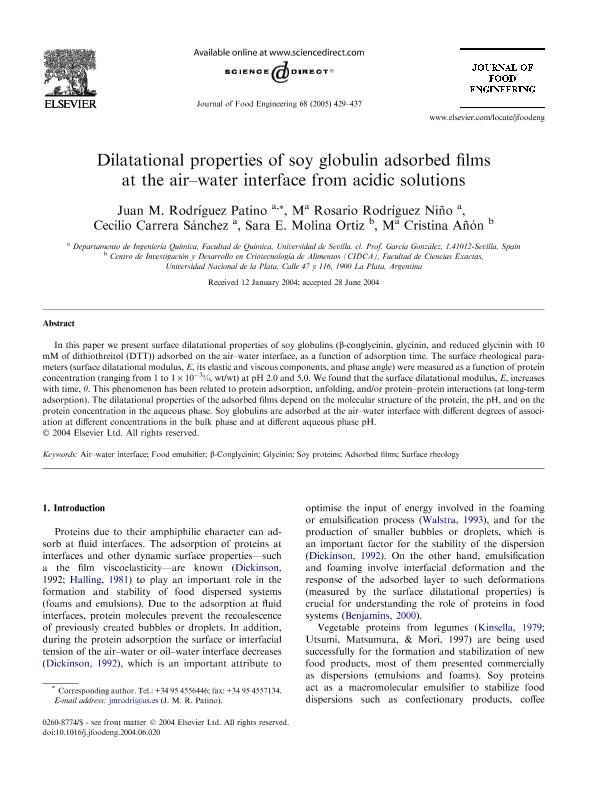Artículo
Dilatational properties of soy globulin adsorbed films at the air–water interface from acidic solutions
Rodríguez Patino, Juan M.; Rodríguez Niño, María Rosario; Carrera Sánchez, Cecilio; Molina Ortiz, Sara Eugenia; Añon, Maria Cristina

Fecha de publicación:
06/2005
Editorial:
Elsevier
Revista:
Journal of Food Engineering
ISSN:
0260-8774
e-ISSN:
1873-5770
Idioma:
Inglés
Tipo de recurso:
Artículo publicado
Clasificación temática:
Resumen
In this paper we present surface dilatational properties of soy globulins (b-conglycinin,glycinin, and reduced glycinin with 10 mM of dithiothreitol (DTT)) adsorbed on the air–water interface,as a function of adsorption time. The surface rheological parameters (surface dilatational modulus, E,its elastic and viscous components,and phase angle) were measured as a function of protein concentration (ranging from 1 to 1 · 103%,wt/wt) at pH 2.0 and 5.0. We found that the surface dilatational modulus, E,increases with time, h. This phenomenon has been related to protein adsorption,unfolding, and/or protein–protein interactions (at long-term adsorption). The dilatational properties of the adsorbed films depend on the molecular structure of the protein,the pH,and on the protein concentration in the aqueous phase. Soy globulins are adsorbed at the air–water interface with different degrees of association at different concentrations in the bulk phase and at different aqueous phase pH.b-conglycinin,glycinin, and reduced glycinin with 10 mM of dithiothreitol (DTT)) adsorbed on the air–water interface,as a function of adsorption time. The surface rheological parameters (surface dilatational modulus, E,its elastic and viscous components,and phase angle) were measured as a function of protein concentration (ranging from 1 to 1 · 103%,wt/wt) at pH 2.0 and 5.0. We found that the surface dilatational modulus, E,increases with time, h. This phenomenon has been related to protein adsorption,unfolding, and/or protein–protein interactions (at long-term adsorption). The dilatational properties of the adsorbed films depend on the molecular structure of the protein,the pH,and on the protein concentration in the aqueous phase. Soy globulins are adsorbed at the air–water interface with different degrees of association at different concentrations in the bulk phase and at different aqueous phase pH.E,its elastic and viscous components,and phase angle) were measured as a function of protein concentration (ranging from 1 to 1 · 103%,wt/wt) at pH 2.0 and 5.0. We found that the surface dilatational modulus, E,increases with time, h. This phenomenon has been related to protein adsorption,unfolding, and/or protein–protein interactions (at long-term adsorption). The dilatational properties of the adsorbed films depend on the molecular structure of the protein,the pH,and on the protein concentration in the aqueous phase. Soy globulins are adsorbed at the air–water interface with different degrees of association at different concentrations in the bulk phase and at different aqueous phase pH.· 103%,wt/wt) at pH 2.0 and 5.0. We found that the surface dilatational modulus, E,increases with time, h. This phenomenon has been related to protein adsorption,unfolding, and/or protein–protein interactions (at long-term adsorption). The dilatational properties of the adsorbed films depend on the molecular structure of the protein,the pH,and on the protein concentration in the aqueous phase. Soy globulins are adsorbed at the air–water interface with different degrees of association at different concentrations in the bulk phase and at different aqueous phase pH.h. This phenomenon has been related to protein adsorption,unfolding, and/or protein–protein interactions (at long-term adsorption). The dilatational properties of the adsorbed films depend on the molecular structure of the protein,the pH,and on the protein concentration in the aqueous phase. Soy globulins are adsorbed at the air–water interface with different degrees of association at different concentrations in the bulk phase and at different aqueous phase pH.
Archivos asociados
Licencia
Identificadores
Colecciones
Articulos(CIDCA)
Articulos de CENTRO DE INV EN CRIOTECNOLOGIA DE ALIMENTOS (I)
Articulos de CENTRO DE INV EN CRIOTECNOLOGIA DE ALIMENTOS (I)
Citación
Rodríguez Patino, Juan M.; Rodríguez Niño, María Rosario; Carrera Sánchez, Cecilio; Molina Ortiz, Sara Eugenia; Añon, Maria Cristina; Dilatational properties of soy globulin adsorbed films at the air–water interface from acidic solutions; Elsevier; Journal of Food Engineering; 68; 4; 6-2005; 429-437
Compartir
Altmétricas



